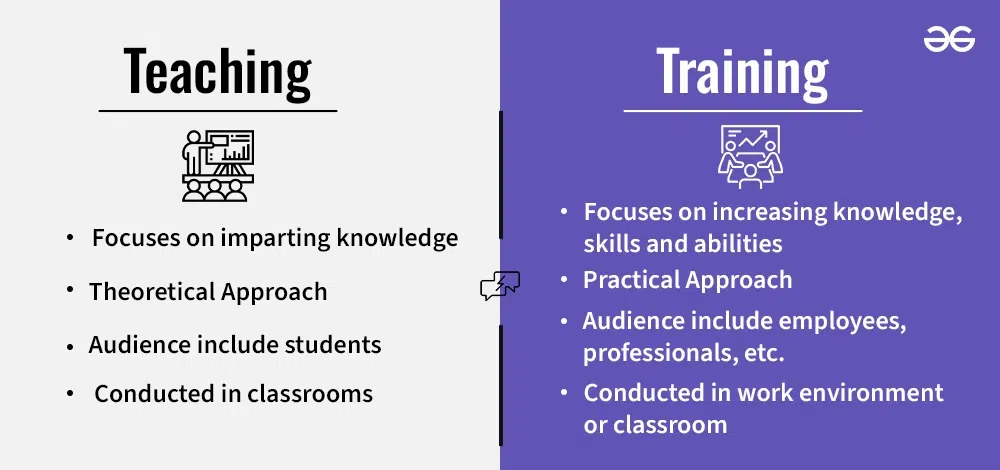Difference between Teaching and Training
Last Updated :
07 Apr, 2024
Teaching and Training are essential for individual development and organizational success, but they serve different purposes and require distinct approaches. Teaching focuses on imparting knowledge and fostering understanding; whereas, Training is more aligned with practical skills acquisition and job performance enhancement.

What is Teaching?
Teaching is a process of facilitating learning, knowledge acquisition, and skill development in individuals through various instructional methods and techniques. It involves the transmission of knowledge, concepts, principles, and skills from a teacher or instructor to learners in a structured and systematic manner.
Features of Teaching are:
- Imparting Knowledge: The primary goal of teaching is to impart knowledge and understanding to students. This involves explaining concepts, theories, principles, and facts related to a particular subject or topic.
- Facilitating Learning: Teaching aims at facilitating the learning process by providing guidance, support, and resources to help students grasp and internalize new information. Teachers use various instructional strategies, methods, and materials to make learning engaging, interactive, and effective.
- Promoting Critical Thinking: Effective teaching encourages critical thinking, problem-solving skills, and analytical reasoning among students. Teachers encourage students to question, analyze, evaluate, and apply knowledge in real-world contexts.
What is Training?
The process of increasing the knowledge, skills, and abilities of employees for doing work is known as Training. It is a process by which attitudes, skills, and capabilities to do a particular job are increased. It is a process of learning new skills and applying knowledge. Its main aim is to improve the performance of the current job and prepare them for any future job.
Features of Training are:
- Skill Development: Training focuses on developing practical skills and competencies that are directly relevant to performing tasks or responsibilities associated with a particular job or role. This can include technical skills, interpersonal skills, problem-solving abilities, and other job-specific competencies.
- Practical Application: Training emphasizes on hands-on practice, application, and experiential learning to reinforce learning and build proficiency. Trainees engage in activities such as simulations, role-playing, case studies, and on-the-job training to gain practical experience and mastery in real-world contexts.
- Task-Oriented Approach: Training adopts a task-oriented approach, focusing on the specific tasks, activities, or responsibilities required for successful job performance. It aims to bridge the gap between current skills and desired competencies, addressing identified learning needs and performance gaps.
Difference between Teaching and Training
|
Basis
|
Teaching
|
Training
|
|
Meaning
|
The process of facilitating learning, knowledge acquisition, and skill development in individuals through various instructional methods and techniques is known as Teaching.
|
The process of increasing the knowledge, skills, and abilities of employees for doing work is known as Training.
|
|
Purpose
|
The primary purpose of teaching is to impart knowledge, understanding, and conceptual learning. It focuses on broadening intellectual horizons, fostering critical thinking, and promoting a deeper understanding of subjects or concepts.
|
The primary purpose of training is to develop specific skills, competencies, and practical knowledge required for performing tasks, jobs, or roles effectively. It aims to bridge the gap between current skills and desired competencies relevant to job performance.
|
|
Emphasis
|
Teaching emphasizes on education, knowledge and wisdom.
|
Training emphasizes on skills and abilities.
|
|
Approach
|
Approach is theoretical. It often involves a broader approach, covering theoretical concepts, principles, and ideas.
|
Training has a practical approach. It involves a more focused approach, emphasizing on hands-on practice and application.
|
|
Audience
|
Teachers typically work with students in formal educational settings, such as schools, colleges, universities, and other academic institutions.
|
Trainers typically work with employees, professionals, or individuals seeking to acquire job-specific skills.
|
|
Outcome
|
The outcome of teaching is to promote intellectual growth, critical thinking, problem-solving skills, and a deeper understanding of subject matter concepts. It aims to broaden students’ knowledge base and foster lifelong learning habits.
|
The outcome of training is to enhance job performance, productivity, efficiency, and effectiveness in specific tasks or roles. It aims to translate knowledge into actionable skills and behaviors, improving overall job performance and contributing to organizational success.
|
|
Methods
|
Teaching methods may include lectures, presentations, discussions, demonstrations, and other instructional strategies aimed at facilitating learning and comprehension.
|
Training methods often include on-the -job and off-the-job methods aimed at building practical skills and competencies.
|
|
Conducted in
|
Teaching is conducted in classrooms.
|
Trainings are conducted in work environment or classroom.
|
Teaching and Training – FAQs
Can teaching and training be combined?
Yes, teaching and training can be combined to create comprehensive learning experiences that integrate both knowledge acquisition and skill development. Blended learning approaches, which combine traditional teaching methods with hands-on training activities, are increasingly popular in educational and professional settings.
Should teaching methodologies incorporate opportunities for student autonomy, choice, and active participation in the learning process?
Yes, student-centered teaching approaches empower learners, encourage intrinsic motivation, and promote deeper understanding through active engagement.
Do teachers play a role in fostering social-emotional skills such as empathy, resilience, and teamwork?
Yes, teachers contribute to students’ social-emotional development through classroom activities, discussions, and modeling of positive behaviors.
Training typically refers to the process of acquiring specific job-related skills and knowledge, while development encompasses broader learning experiences aimed at enhancing overall professional growth, career advancement, and personal effectiveness.
How often should employees undergo training?
The frequency of employee training depends on factors, such as the nature of the job, industry regulations, technological advancements, organizational goals, and employee development needs. Training may occur periodically, as needed, or as part of ongoing professional development initiatives.
Share your thoughts in the comments
Please Login to comment...